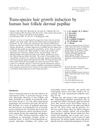Microenvironmental Reprogramming by Three-Dimensional Culture Enables Dermal Papilla Cells to Induce De Novo Human Hair-Follicle Growth
October 2013
in “
Faculty Opinions – Post-Publication Peer Review of the Biomedical Literature
”

TLDR Three-dimensional culture helps dermal papilla cells grow new human hair follicles.
In 2013, Higgins and her team conducted a study that demonstrated for the first time that cultured human dermal papilla cells (DPCs) could induce new hair follicle growth. This was achieved by culturing the cells in three-dimensional (3D) spheroids, a method that partially restored the inductive activity of human DPCs, which was lost in conventional two-dimensional (2D) culture. The researchers performed microarray analyses and found that 3D culture restored several key molecules, but not all. They identified potential master regulators for hair follicle regeneration, suggesting that FLI1 is the master regulator of the regenerative activity. However, the new hair follicles lacked sebaceous glands, and long-term follicle function could not be examined due to the short time frame of the study. Despite these limitations, the study represented a significant advance in using cell-based therapy for the treatment of hair loss.





